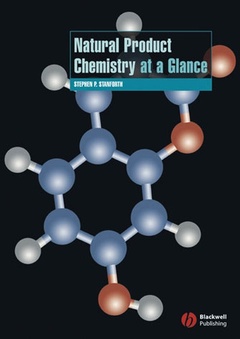Natural Product Chemistry at a Glance Chemistry At a Glance Series
Auteur : Stanforth Stephen P.

Natural Product Chemistry at a Glance provides a concise overview of the main principles and reactions of natural product chemistry, for students studying chemistry and related courses at undergraduate level. Based on the highly successful and student friendly ?at a glance? approach, the material developed in this book has been chosen to reinforce the principles of elementary organic reactions and to highlight the similarity between many organic reactions and biological processes. It will also serve as an initial platform for more advanced excursions into the origin of natural products.
Students using Natural Product Chemistry at a Glance will find they have a resource with which they can quickly, economically and confidently acquire, regularly review and revise the basic facts that underpin the biosynthesis and chemistry of natural products.
1.1 Primary and Secondary Metabolites.
1.2 Properties and Purpose of Secondary Metabolites.
Section 2: Acetyl Coenzyme A: A Key Biological Intermediate.
2.1 What is Acetyl Coenzyme A? 8.
2.2 Comparison of Organic and Acetyl Coenzyme A Reactions.
2.3 Malonyl Coenzyme A – A Partnership with Acetyl Coenzyme A.
2.4 How is Acetyl Coenzyme A Used in Biosynthesis?.
Section 3: Biosynthesis of Fatty Acids.
3.1 What are Fatty Acids?.
3.2 Occurrence and Function of Fatty Acids.
3.3 Biosynthesis of Saturated Straight-Chain Fatty Acids.
3.4 Biosynthesis of Saturated Branched Fatty Acids.
3.5 Mono-unsaturated Fatty Acids.
3.6 Poly-unsaturated Fatty Acid.
3.7 Oxygenated Fatty Acids.
3.8 β-Oxidation.
Section 4: Biosynthesis of Polyketides.
4.1 What are Polyketides?.
4.2 The Chemistry of 1,3-Dicarbonyls: Keto–Enol Tautomerism.
4.3 The Chemistry of 1,3-Dicarbonyls: Condensation Reactions.
4.4 Polyketide Cyclizations: Formation of Unsaturated Products.
4.5 Secondary Structural Modifications During Polyketide Cyclizations.
4.5.1 Alkylation.
4.5.2 Reduction.
4.5.3 Oxidation.
4.5.4 Decarboxylation.
4.5.5 Modifications to the Carbon Skeleton.
4.6 Alkaloids Derived from Polyketides.
4.7 The Use of Isotopes in the Elucidation of Biosynthetic Pathways.
Section 5: The Shikimic Acid Pathway.
5.1 Introduction.
5.2 Transamination.
5.3 Biosynthesis of Natural Products Derived from Cinnamic Acid.
5.4 Lignans.
5.5 Biosynthesis of Alkaloids.
5.5.1 Decarboxylation of Amino Acids and α-Keto Acids.
5.5.2 Pictet–Spengler Reaction.
5.5.3 Alkaloids Derived from Tryptophan.
5.5.4 Alkaloids Derived from Tyrosine.
Section 6: Terpenes.
6.1 What are Terpenes?.
6.2 Carbocations as Intermediates in Terpene Biosynthesis.
6.2.1 Hydride Shifts.
6.2.2 Alkyl Shifts.
6.2.3 Cyclizations.
6.3 Termination of Carbocations.
6.3.1 Loss of a Proton.
6.3.2 Addition of Water.
6.4 Terpene Biosynthesis.
6.4.1 Biosynthesis Initiated by Heterolysis of Pyrophosphates.
6.4.2 Biosynthesis from ‘Dimers’ of Pyrophosphates.
6.4.3 Biosynthesis Initiated by Protonation or Epoxidation of an Alkene.
Section 7: Natural Products Derived from Amino Acids.
7.1 Alkaloids.
7.2 Penicillins and Related Compounds 1.1 Primary and Secondary Metabolites.
7.3 Macrocyclic Peptides.
7.4 Porphyrins.
Section 8: Answers to Problems.
Section 9: Further Reading.
Index
Date de parution : 08-2006
Ouvrage de 148 p.
21.1x29.7 cm
Thème de Natural Product Chemistry at a Glance :
Mots-clés :
investigation; area; years; fertile; products; many; natural; chemical; development; synthetic reactions; new; chemistry; analytical; important; quest; main; reactions; glance; concise; principles; overview
